Southbound for the Season
Since we got off to a bit of a late start this season, our plan was to make good time to get all the way down to Banderas Bay by the weekend after Thanksgiving. Our experience in past seasons in the Sea of Cortez Gulf of California is that the weather in the sea really starts to fall apart right after Thanksgiving. Gloriously warm and gentle breezes quickly turn to a steady march of strong, cold northerlies that leave you either stuck in port or scrambling to the next safe anchorage before the next round of northerlies. This gave us a mere 2 weeks to sail over 550 miles south to Banderas Bay.

San Carlos to Agua Verde
For our first leg we decided to retrace our route from Season 2 and head directly south to Agua Verde. For Sonrisa this is approximately a 24-hour run 140 miles due south. We had planned on leaving Saturday November 11, but as the date approached we felt we could use one more day for provisioning and Sunday looked like a somewhat better weather window.
We departed at 8 AM under very light winds and motored for the first few hours out of San Carlos. By noon the wind had filled in enough to try out our new sails and we spent the next few hours playing with the sheeting angles to start to get used to these new sails. While they are essentially the same as the old sails, there’s enough subtle differences where we found that our default block positions on the sail tracks (which determines the angle of the line attached to the end of the sail) weren’t quite what they were before. Slide this car forward a bit, that car back a bit and after some fussing we could see the tell tales on the sails start to indicate that the sail was trimmed appropriately.
Deploying the staysail was exciting as the new roller furler meant that we simply un-rolled the sail from the cockpit and roll it back up when we’re done rather than having to make a trip to the foredeck to hoist and douse the sail. We can see ourselves playing with the staysail much more frequently with it being so simple to pull out and put away.
By evening the wind had died again and we motored through the moonless night to Agua Verde. Even though there was no moonlight, the stars were bright enough to illuminate the water enough to see the waves. You would think that a moonless night would be dark enough to be disorienting but with clear skies the stars provide a surprising amount of light. While we still prefer to do night passages on a full moon, I found a new appreciation for new moon passages so long as the skies are clear.
We started our watch schedule which we modified a bit at the end of last season. Kristin takes the 7 PM to 10 PM and 1 AM to 4 AM watches, I take 10 PM to 1 AM and 4 AM to 7 AM watches.
I had just started my second watch at 4 AM when I noticed the wind picking up again. Not a lot, but enough and from a good angle to make an easy sail. I debated whether the few minutes of noise unfurling the sails would be worth the hours of silent running under sail for Kristin trying to sleep below. With the roller furlers I was able to slip both headsails out with a minimum of fuss and clanging and once the engine was turned off and the windvane took over from the electric autopilot, things settled down quite nicely for the next few hours. The activity of working the sails gave me a much needed jolt of energy to keep me alert for my watch and I was hoping that Kristin was enjoying overdue silence for her off-watch sleep.
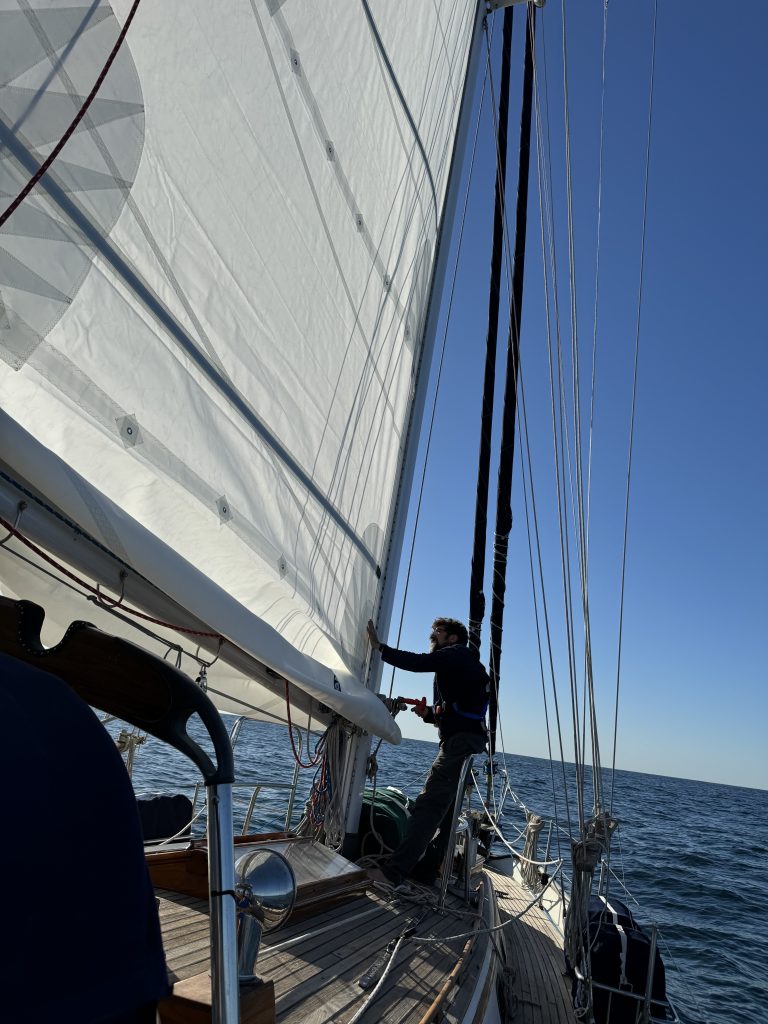
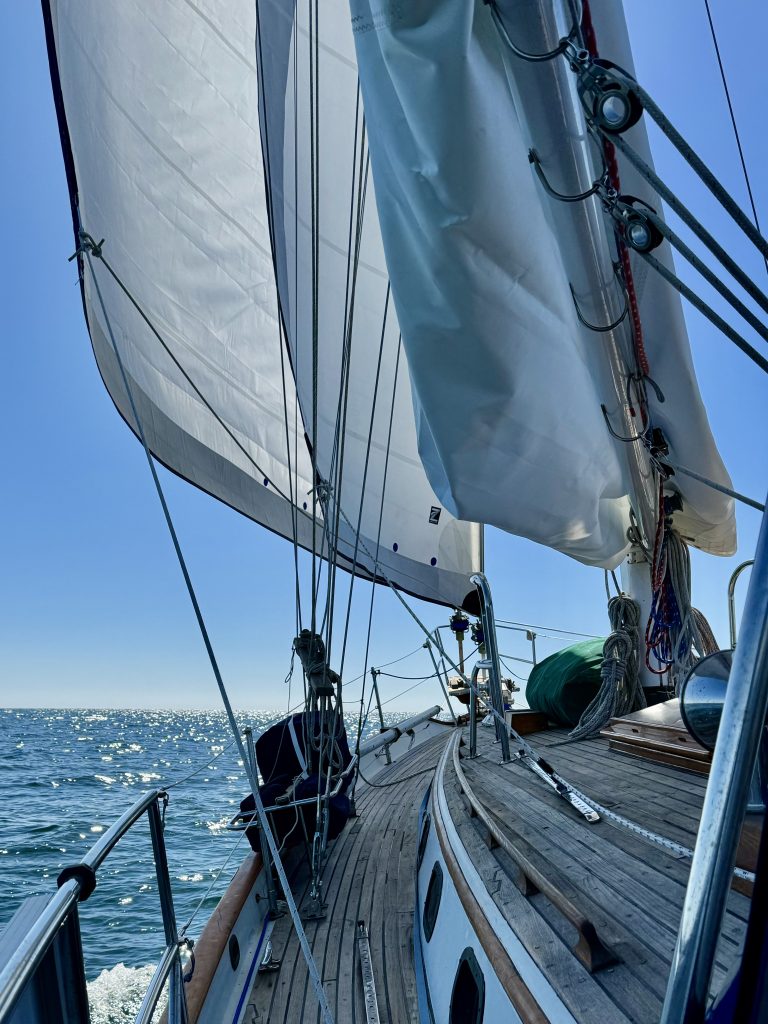



Dawn broke as we were approaching Isla Monserrat, a few hours away from Agua Verde. The wind was getting light but I waited until after the Amigo net on the SSB radio. It’s always better to hear faint broadcasts with the engine and autopilot off.
After the signing off of the radio net I popped up to the cockpit to fire up the engine and get moving again. By now the wind was very light, although we were still managing 4 knots. I twisted the key in the ignition and the starter replied with a short grunt and stopped. I looked at Kristin and tried again, “grunt.”
“The starter battery is dead!” as I stated the obvious.
“How is that possible?” Kristin groused in disbelief.
Indeed it shouldn’t have been possible. The starter battery is completely isolated from the house batteries that run everything on the boat. The starter battery’s only job is to start the engine. Once started, the starter battery charged off of the house bank via a Victron DC-DC charger. Could I have forgotten to turn the charger back on when we commissioned the boat? Or maybe the old “maintenance free” starter battery failed without warning.
“I’m going to have to jump it from the house bank. We have plenty of juice left there.” I explained, thinking out loud with my plan of action. “I’ll need to get to the batteries and dig out the jumper cables though.” This would require moving all of the assorted stuff including a heavy mainsail we’re delivering for a friend off of the aft cabin bunk to get to the battery boxes. As I was imagining where the jumper cables were stashed I had another thought. I remembered that the Victron DC-DC charger that connects the house bank to the starter bank had two modes. One mode was “charging” that senses when the engine is running and charges the starter battery. The other mode was “power supply” that simply supplies a steady 12v current to the load side of the unit. I figured that if I put the charger into “power supply” mode, it would take whatever current it needed from the house bank and push 12v onto the starter circuit, up to its 30 amp maximum.
“Hold on, I’m going to try something.” I said to Kristin as I pulled out my iPhone and logged into the Victron charger’s bluetooth interface. I flipped the switch from “charger” to “power supply” and watched the output voltage immediately pop up. I figured the charger wouldn’t want to run this way for very long, so I counted to 20 and tried the starter.
“Vrooom” the engine immediately came to life and I quickly switched the charger back to “charger” mode and watched as it started it’s normal charge cycle.
“What did you do?” Kristin asked in disbelief.
“I jumped the starter battery.”
“With your phone?!?”
“Yup.” I replied matter-of-factly as if that’s a totally normal thing to expect of an iPhone. I let that moment sit for a beat before explaining how I actually did it by changing the behavior of the charger connecting the two banks.
With the engine purring and the batteries charging we motored the final leg into Agua Verde. By 9:30 AM Monday morning we were sitting quietly in the beautiful anchorage where we would stay for the week.
While we were there some of the Tenacatita regulars started to arrive for their annual Thanksgiving stay in Agua Verde. We even got a game of Bocce in on the beach before it was time for us to move on.

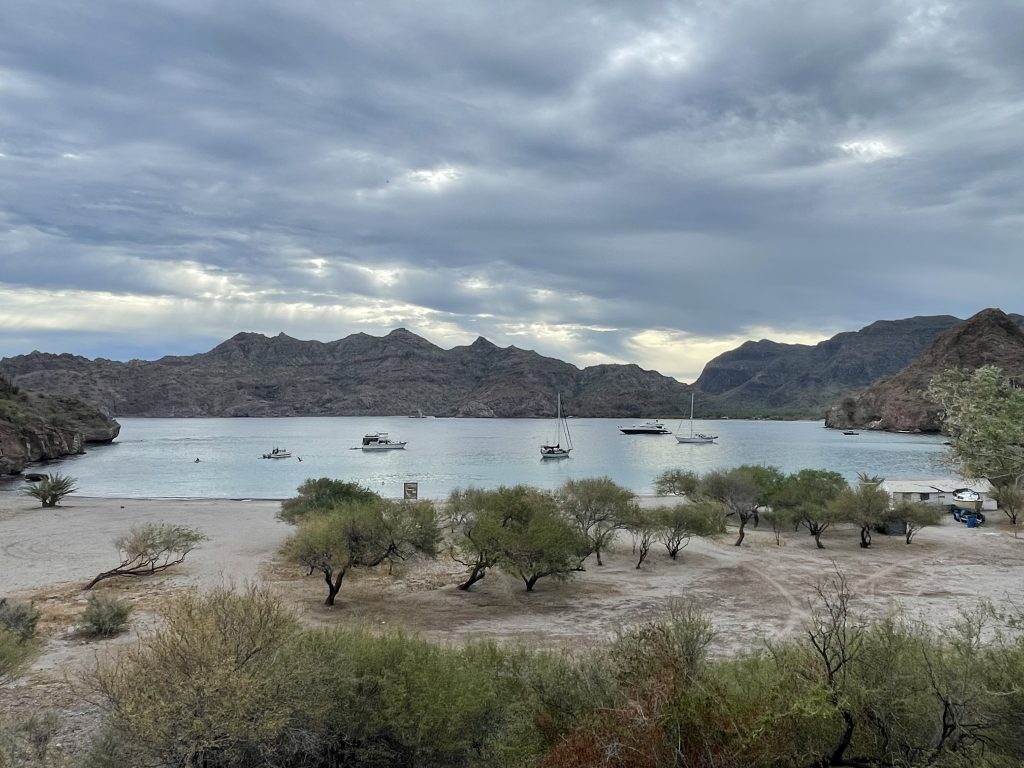
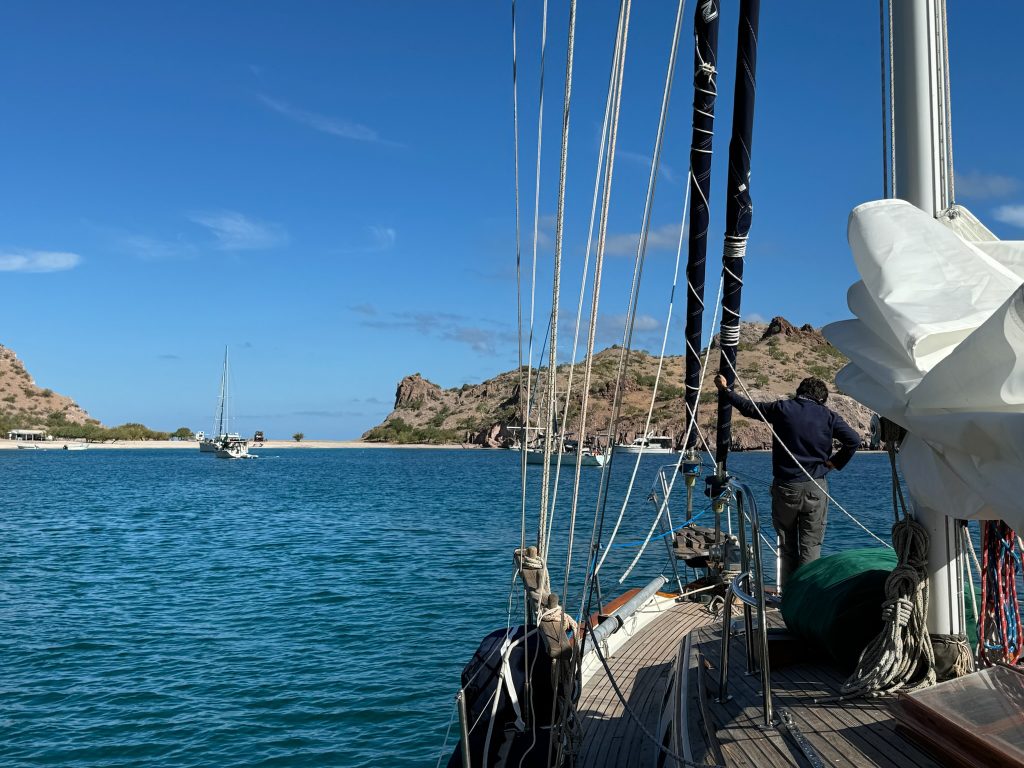




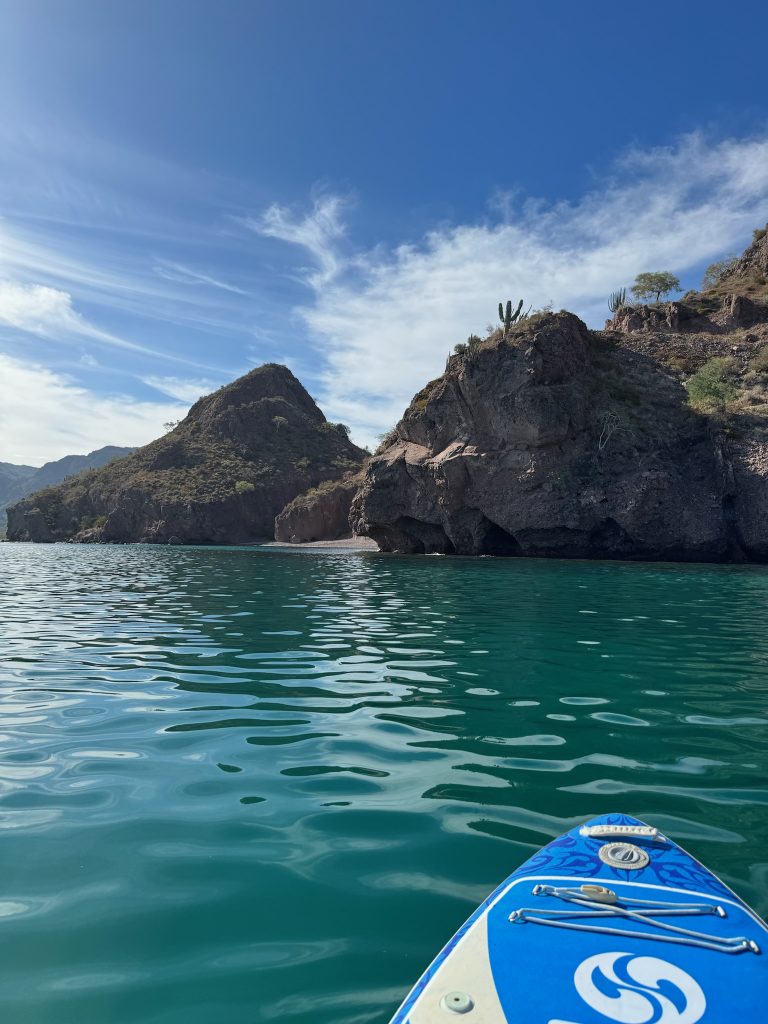
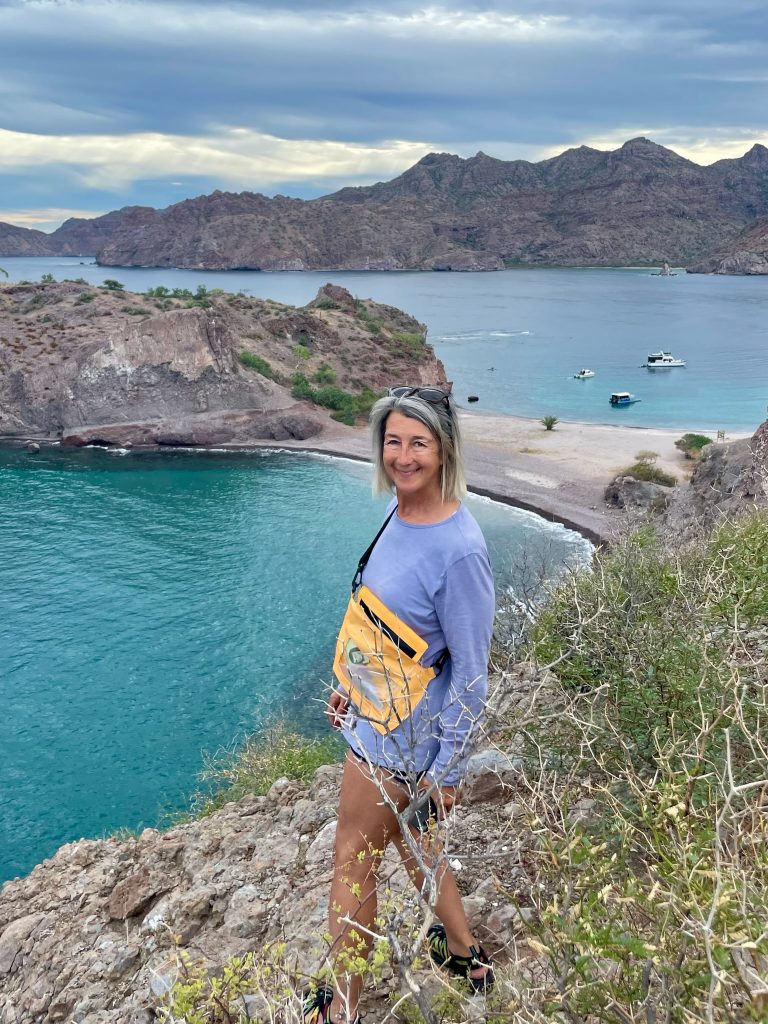

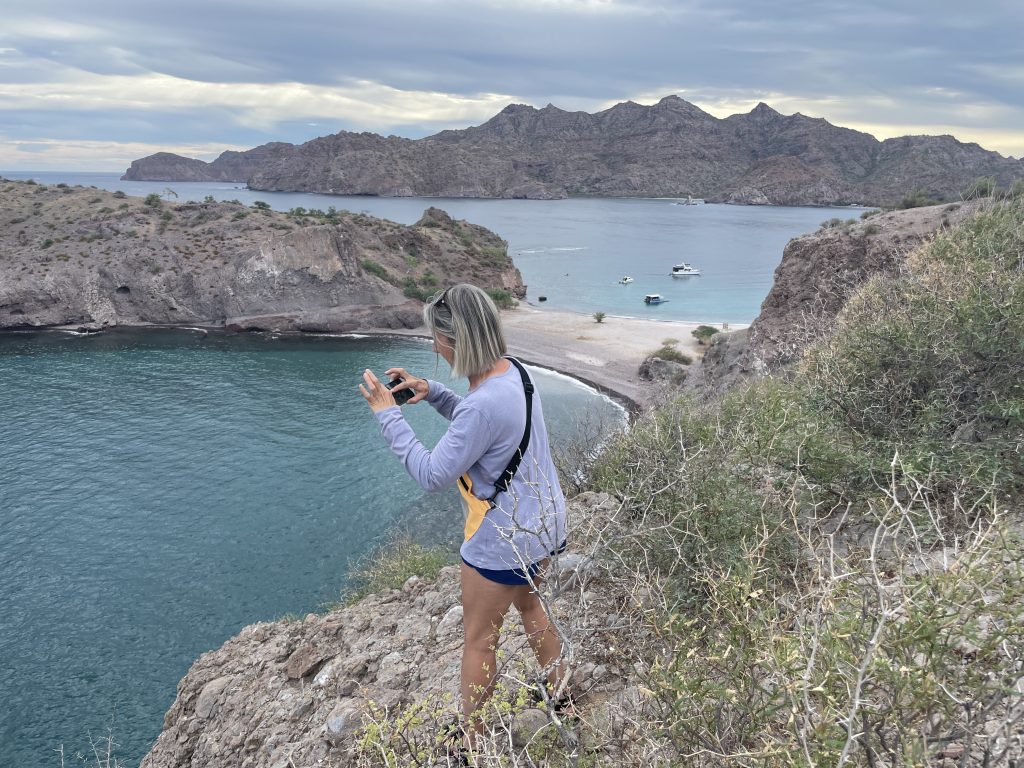


Agua Verde to San Evariso
After a picturesque week in Agua Verde, we were really feeling pressed to get moving south. On Saturday, November 18 we set sail for San Evariso, an easy 46 mile day sail to the south. We started motoring in very light winds but within a couple of hours the wind had picked up enough to sail the rest of the way. We’re starting to notice that we seem to be able to make better speed in lighter winds with the new sails. On a reach to San Evariso in 7-8 knots apparent wind we were able to maintain 5 knots which is pretty good for a heavy boat in lighter winds.
On this leg we saw plenty of dolphins and saw some rays doing crazy backflips out of the water. It seemed like they were competing to see how many revolutions they could get before splashing back down into the water. We counted 2-3 flips with each leap as Kristin and I ooh’d and aah’d over their performance.
Shortly after the acrobatic ray show we latched into our first fish of the season. Kristin saw my hand line bounce and yelled, “You’ve got a fish!”
As I untied the handline spool from the rail the familiar first thought came to mind, “Ok, what is it? Am I going to be excited or disappointed?” Usually the first few moments are telling. If the line is taught like dragging a dead weight and not much is visible from the surface, it’s probably a skipjack which we throw back. But this time as I pulled the line to set the hook I immediately saw a yellow-green flash and a beautiful dorado leapt out of the water shaking his head. For the next few minutes I worked the line up to the side of the boat, giving both of us a good workout. Once alongside, the fish seemed tired from its struggle and layed quietly alongside the hull as I prepared to land it. I could see it was a big male dorado, its green and yellow body contrasting with the bright blue pectoral fins.
“Get the gaff!” I called to Kristin as I gathered the line.
We usually don’t gaff our fish to land them. Sonrisa’s freeboard is low enough we’ve always been able to time the roll of the waves and slide the fish on the hook up onto the side deck. The fish was laying there so quietly in that moment I figured I could slide him up on deck the same as we’ve done with smaller fish. But the moment his head came out of the water he did a backflip and spun himself right off the hook. I watched dismayed as the lure sprang into the air and the beautiful fish darted away from the boat.
“Crap! I lost it!” I cried in disbelief.
“What!?! How’d he do that?” Kristin asked.
“He just flipped and spun himself right off the hook somehow,” I signed.
Undaunted, we set the lines again. Determined to get a fish.
“I got one!” Kristin exclaimed not more than an hour later. At the same time I saw my line get hit but as I started pulling it up it immediately went slack. Kristin pulled in our second dorado of the day, a small female. We brought her up on deck and carefully removed the hook as we debated whether to keep her or not. I’m not sure if it was just a comparison to the one that just got away, but it seemed a bit small. While I was pretty sure I’d seen dorado her size in the fish market, being a female and on the smaller side we quickly decided to give her another chance to make some more dorado and slid her back into the ocean where she immediately torpedoed away.
While we were feeling a bit disappointed that we still didn’t have a fish for dinner, we felt good about letting one go too.
Curious about the one that struck my line I checked my lure and found that he barb on the hook had completely broken off. That’s probably what happened to the first fish and why the strike I had on the next one didn’t stay! I rummaged around in our makeshift tackle box and found a new hook with a good strong barb to tie onto the lure.
“Ok, let’s try this again!” I proclaimed.
As we approached our turn our of the channel and into San Evariso it was looking like we wouldn’t have fish for dinner when “Clank” my handline spool sprang to attention and the line went taught.
“I can’t believe we got another one!” I exclaimed as I tugged the line to set the hook. In a single day we’ve hooked more dorado that we have in entire seasons in past years. “This one is not getting away.”
I finally landed the third dorado without incident – a larger female which we would keep. Since we were so close to the anchorage we landed and dispatched the fish and hung it up to bleed while we anchored. By the time we had the anchor down the fish was ready to fillet for dinner in an hour or so and several more meals-worth of fillets to go into the freezer.



San Evariso to Bahia Falsa
When we arrived in San Evariso we saw that our friends on S/V Cake were also there. They came over in the dinghy at some point and we talked about the impending norther that was forecast to hit in a couple of days. After that it looked like there was a great window opening up to cross back over to the mainland which we wouldn’t want to miss.
The complication was fuel. Since we had motored most of the way from San Carlos to Agua Verde and the predicted weather window to cross back over to the mainland looked like there would be little to no wind it put us in a bit of a logistical bind. By my calculations with the reserve 15 gallons of fuel we carry on deck, we might have just enough fuel left to make it to La Cruz if we had to motor the entire way. Maybe. But our planned route to La Cruz puts us nearly 100 miles offshore at the mid-point and I’d feel a lot better if we had more of a cushion of fuel if there’s no wind.
So we had a couple of choices. We could wait out the norther in San Evariso, then when it clears run down to La Paz to get fuel, then immediately turn around and continue down (likely overnight) to Bahia Muertos to stage for our crossing. Or skip La Paz and cross over to Mazatlan instead where we could easily reach with our available fuel. But then that puts us still 2 days from La Cruz and behind schedule.
Cake suggested we make a run the next day from San Evariso to Bahia Falsa, just outside of La Paz. They said it’s a good hideout from northers and we would be much closer to get fuel and continue on. The weather for the next day looked a bit spirited, 18-20 knots, but should be manageable.
So the next day we departed San Evariso at 10 AM bound for Bahia Falsa. As we exited the San Jose channel the swell became taller and steeper, making for a rolly sail south toward La Paz. Cake called us on the radio to find out what conditions were like further south and I told them it was rolly but not terrible. Trying to find a comfortable wind angle we hugged Isla San Francisco as we got into the lee of where the San Jose channel meets the sea. As we put some distance between ourselves and Isla San Francisco, the swell became less washing-machine like and a more consistent following sea. For the next 3 hours the Monitor windvane steered through the 6-8 foot short swell as we approached the western side of Isla Partida. We knew that once we were behind the island we’d get a good reprieve from the swell. Nevertheless Sonrisa barged her way through the sloppy seas and kept us reasonably comfortable.
Once in the lee of the islands, the swell subsided to nothing but we also lost the wind, so back to motoring for most of the rest of the way to Bahia Falsa.
It took us a bit longer than expected to get to Bahia Falsa, arriving shortly after dark at 6:45. One of our rules is to not pull into an unfamiliar anchorage after dark, but once we felt our way into the bay with our chartplotter, radar and depth-sounder guiding the way we could see that there were only 2 other boats in the anchorage and we could easily find a safe spot in the dark.
After dropping the anchor we settled in for a good night’s sleep surrounded by the rocky hillsides that would offer us protection for the next couple of days.
As it happened, one of Kristin’s good friends she met our first season at the farmers market in La Paz happened to be back in town for a short visit. We hadn’t planned on being close to La Paz but since we would be in the area for a few days Kristin got in touch with her and told her we could meet her at the beach restaurant if she could find a ride from La Paz.
It was such an amazing happenstance that we could have dinner and drinks and catch up with our friend while we waited out the norther. But these are the kinds of things that happen when you’re cruising!

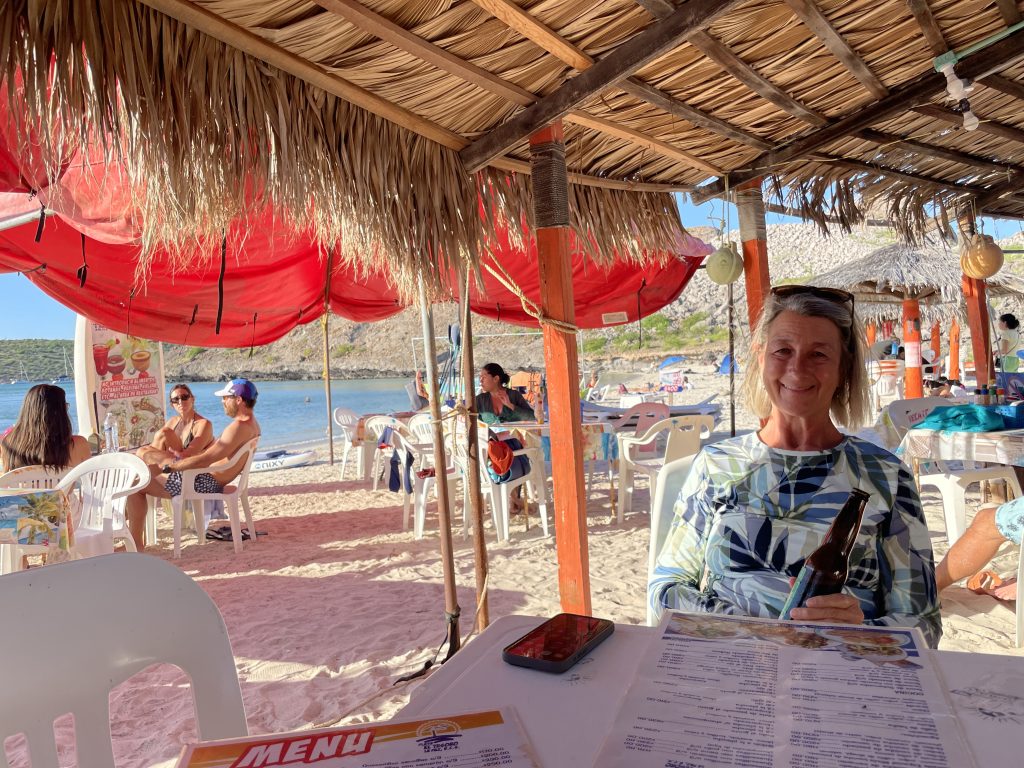




Bahia Falsa to Bahia Muertos
The norther arrived on Monday as forecast and blew through Tuesday. In the safety of Bahia Falsa it seemed like a non-event, but we heard later from our friends who stayed in Agua Verde that it was a particularly fierce blow. We checked the weather forecast for the next several days. If we left Bahia Falsa on Wednesday, we would catch the tail-end of the norther and perhaps have good sailing or perhaps have a lousy sea-state. But if we waited for another day we were pretty much guaranteed to have very calm conditions for the next several days. If we were more hardcore we would have rode the norther south to La Cruz, but we decided to hit the easy button and opt for a lazy motor-sail instead.
We departed Bahia Falsa at 7 AM on Thanksgiving day and arrived in Bahia Muertos early enough to paddleboard in and get to the beach restaurant before they closed to have our “Thanksgiving” dinner of bacon-wrapped prawns, carne fajitas and a huge pile of delicious guacamole.



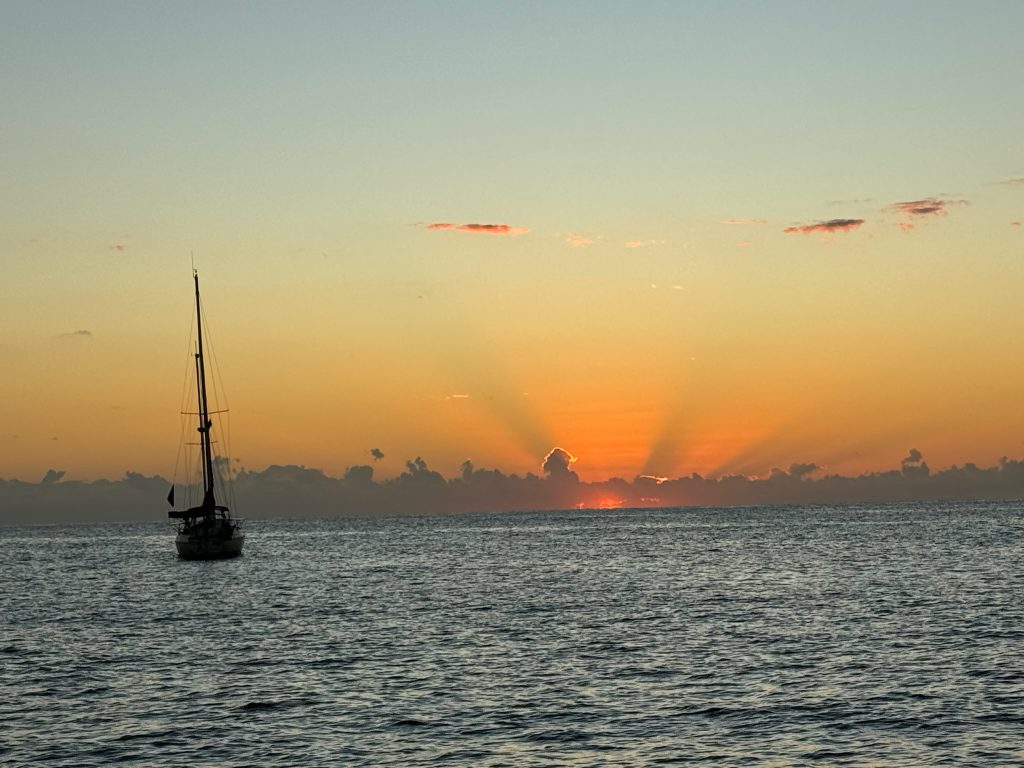

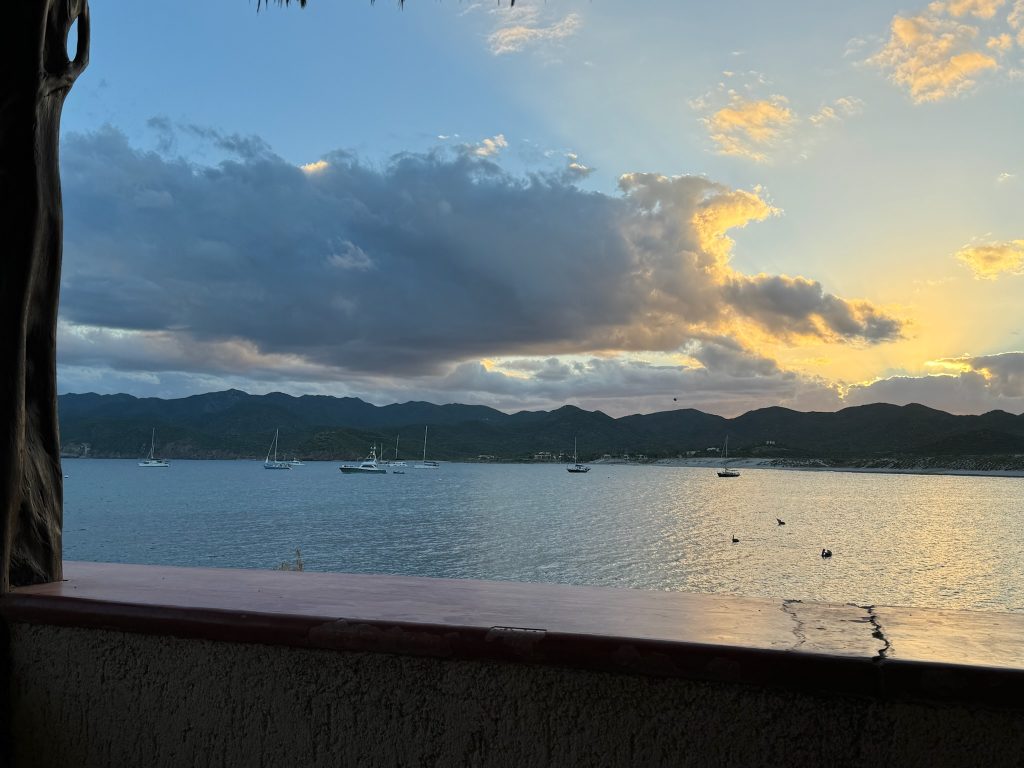
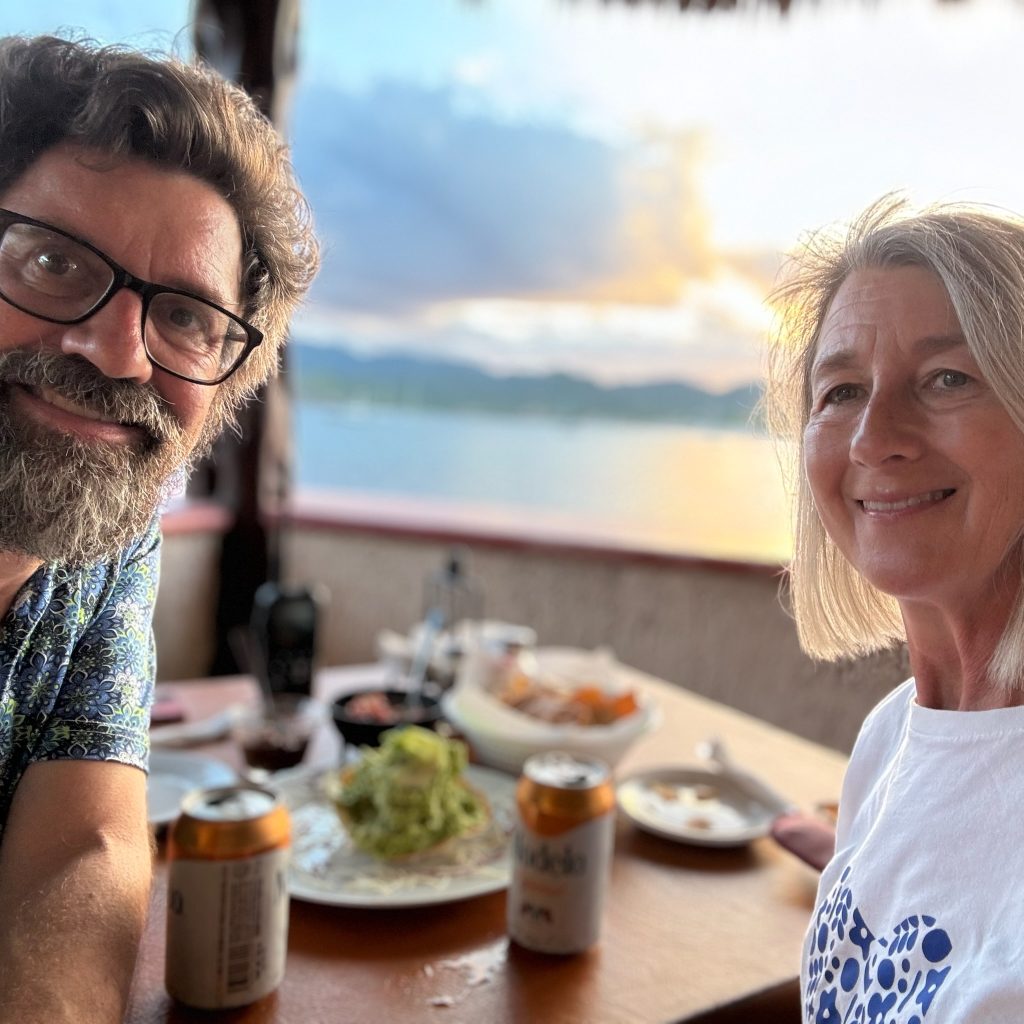
Bahia Muertos to La Cruz de Huanacaxtle
Time was running out and it was time for our big 322-mile crossing from Bahia Muertos on the Baja peninsula to La Cruz de Huanacaxtle in Banderas Bay on the Pacific Mexico mainland. We got up at dawn to weigh anchor and start our long crossing. The engine started, but the starter definitely sounded sluggish on the weak starter battery. Kristin took her position at the helm while I went forward to raise the anchor. I was giving hand signals to Kristin to position the boat over the anchor chain as I worked the windlass to pull up the chain. Counting the markers on the chain I could see that all of the extra chain was in and I was about to pull the anchor free from the bottom when suddenly I heard Kristin yell “Greg! Greg! The engine! It just stopped!”
“What!?!?” I called back in disbelief.
I immediate mashed the anchor-down button on the windlass and let out all of the chain I just pulled in and ran back to the cockpit.
“It just stopped!” Kristin explained.
I tried the key in the ignition. The starter groaned with the weak battery, but was turning the engine over and we could hear the engine trying to catch. I paused and tried the ignition again. Same.
At this point with the weak starter battery I figured that there’s something else going on and I only have a few more tries on the battery before the problem gets compounded with a dead battery. I went below and pulled the stairs off that cover the engine.
On an old-school mechanical injection diesel like ours, the only things the engine needs to run are fuel, air, and compression. There are no computer controls so as long as the engine is turning, the pistons are working and the air and fuel are flowing it WILL run, with or without an electrical system.
My first thought was perhaps there was an air bubble in the fuel line. I could see that the fuel looked good in the clear inspection bowl on our Racor filter and there wasn’t any obvious air showing at the filter. So I reached behind the oil filter where there is a manual activator for the fuel pump to see if I could feel air in the line there. The activator is a small lever you flick with your thumb to pump fuel through the system. If it was sucking air I could probably feel the difference in the resistance of the pump lever.
As I was feeling around for the lever my hand brushed against something behind the engine I didn’t recognize. Plastic of some sort. I tugged on it but it didn’t want to budge from that angle. Looking behind the engine on that side I saw the problem. A ziplock bag of zip-ties had worked it’s way out of the drawer that sits above the engine and fallen next to the air filter intake which managed to perfectly suck it up into the intake and stall the engine.
“Here’s the culprit.” I said, tossing the bag with a circular impression from the air intake into the cockpit. “No air.”
I tried the ignition again and the old battery held in there for one more start as the engine came to life like nothing had happened.
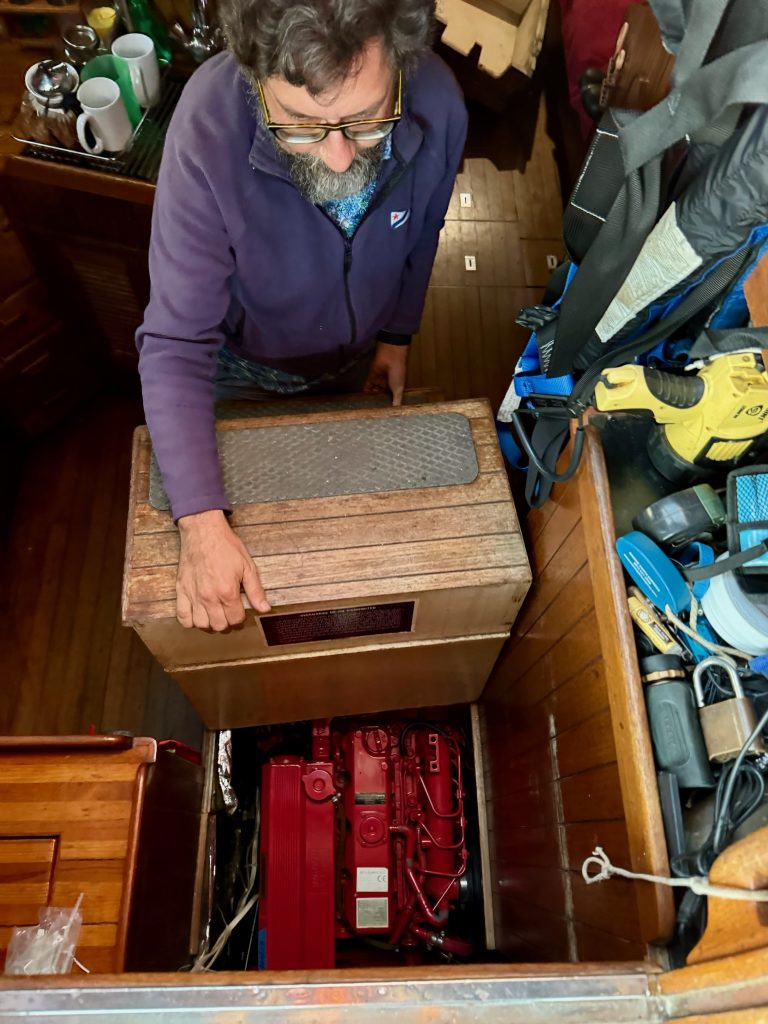
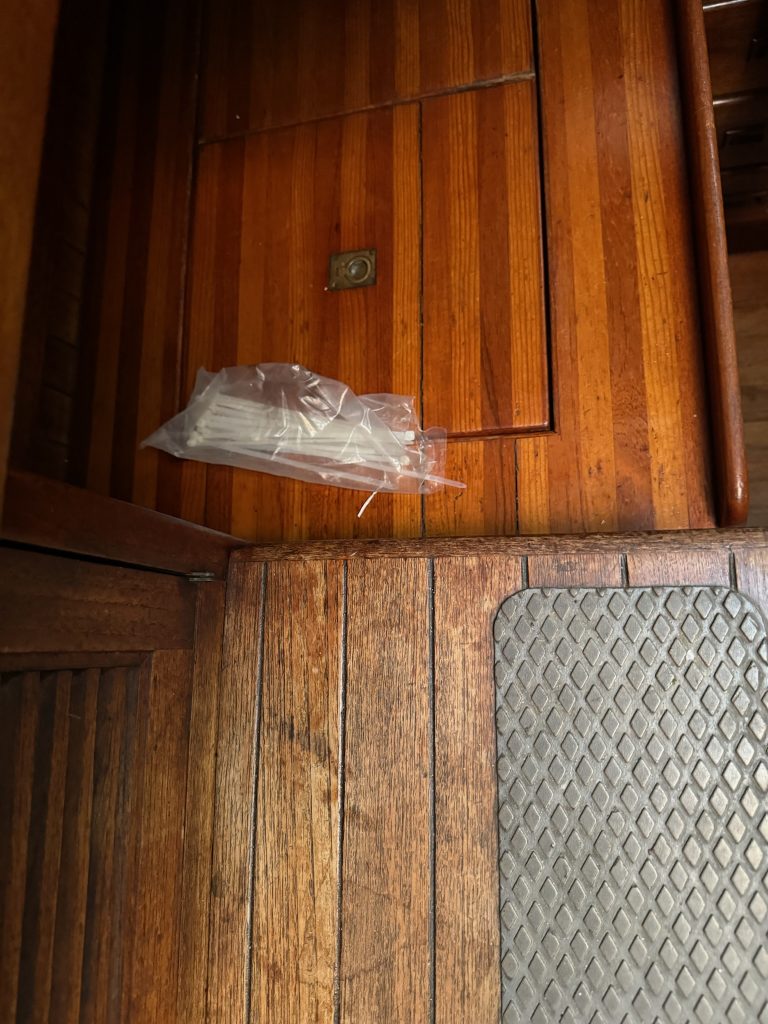
We departed Bahia Muertos at 7 AM in calm conditions. Calm enough, in fact, to run the watermaker and top up the tanks in preparation for a month’s stay at Marina La Cruz (the intake for the watermaker isn’t very deep on the hull and if it’s too rolly the watermaker pump will suck air and stop). We use our watermaker exclusively for onboard fresh water, so we always have to ‘stock up’ before we arrive at a marina so that we don’t run out of water. With a few exceptions, the water at marina docks in Mexico is not typically potable and there’s too much of a chance of picking up oil or some other contaminant to run the watermaker at the dock.
As we motored we were able to run our watermaker until noon at which point both of our 75-gallon tanks were completely full.
As the afternoon progressed, we found ourselves pushing against an unexpected south-easterly wind which was right on our nose. For the next 14 hours we managed 5.5 knots against an 8-10 knot headwind. A brown booby hitched a ride on the bow for most of the night.
By morning the adverse wind had died and the sea became an other-worldly smooth expanse of glass as we motored far from land. By noon we were about half-way across and at about 50 miles from the most northern of the Tres Marias islands. I had been watching on AIS two sailboats adrift just off of our course. I watched as they remained motionless on the glassy sea miles from shore in any direction. Thinking that perhaps they were becalmed with engine trouble I hailed them on channel 16.
“Just thought I’d check to see how you’re doing out here.” I radioed.
“Oh we’re fine. Just taking a little break and going for a swim.” They replied.
“Yeah, great conditions for that.” I agreed.
“Hey, just so you know if you’re going past the Tres Marias, check your chart. The Navy is patrolling the park boundary and they chased us out. It was totally my fault, I wasn’t zoomed in close enough on the chart plotter to see the boundary. Not a problem, but just be aware.” They warned.
“Roger that, thanks for the info. Have a good swim.” I replied.

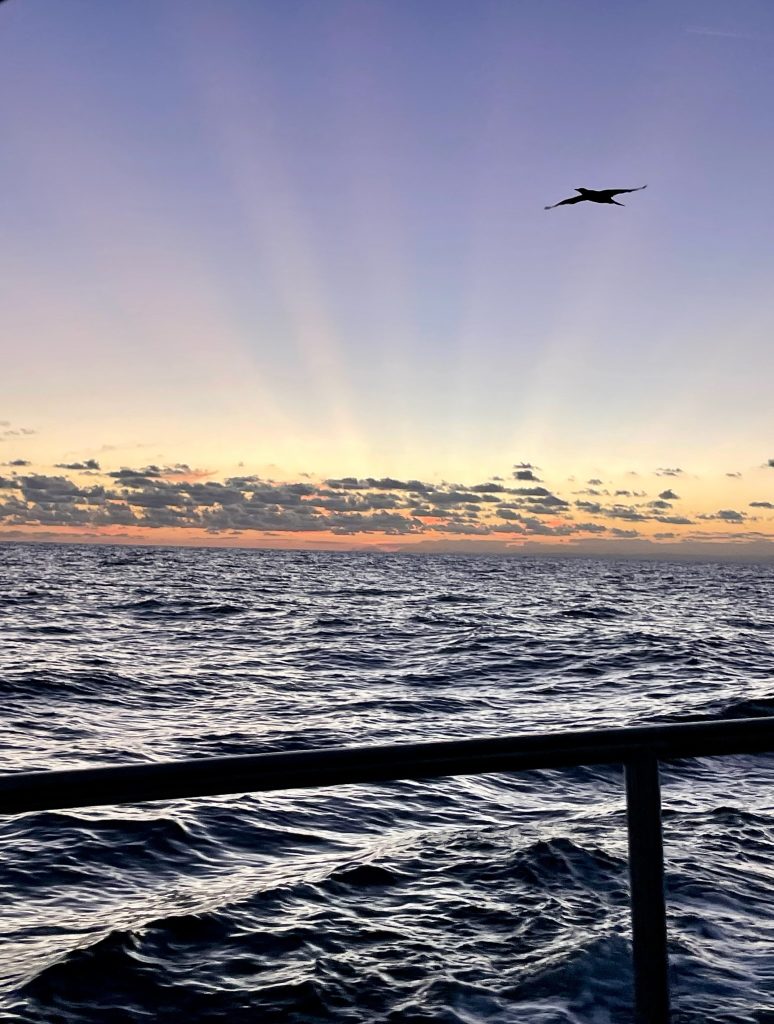


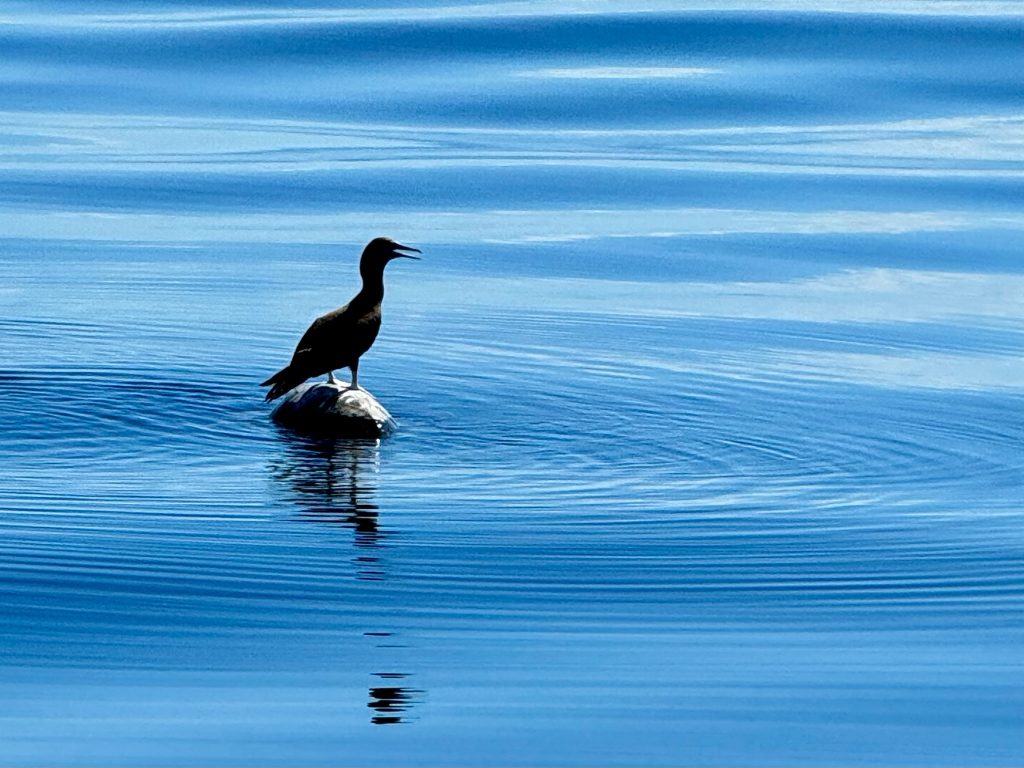


Turning to our new chart plotter, I zoomed in to the islands and just like that a thin red line appeared boxing in the islands and crossing our course. We would have had the same issue. I adjusted our waypoints to (barely) skirt the western boundary of the park and adjusted the autopilot to correct our course.
We started our watch schedule as usual at 7 which according to the chartplotter would put us off the Tres Marias overnight. Each of our first watches were uneventful with nothing to report as we changed watches.
I came up to start my 4 AM watch and Kristin reported, “Kind of spooky this last watch. When we were passing the islands I saw on the radar a boat coming right for us from between Isla Maria Madre and Isla Maria Magdalena. They were clearly on radar, but nothing on AIS and no running lights. I could only see a single white light. They were coming quite fast directly toward us, then when they were about a mile from us they turned 90 degrees and exactly paralleled our course and speed for an hour or more, then it turned and headed back toward the island.”
“Oh yeah, that was the navy for sure.” I rationalized. “Military boats don’t broadcast on AIS and don’t necessarily show navigation lights. Our course is just about a mile from the park boundary so they were shadowing us to make sure we didn’t get any closer. We’re lucky we radioed those guys earlier today and they warned us of the park boundary. If I hadn’t adjusted our course we likely would have been boarded by the navy in the middle of the night.”
“Wow. And of course it would have been on my watch,” Kristin complained.
“Of course!”
Shortly after sunrise we got some favorable wind and we were able to shut the motor off for a few hours and enjoy some gentle sailing conditions as we ticked off the final miles to La Cruz.
By noon we were passing Punta Mita and entering Banderas Bay and the motor was back on. I fired up the watermaker to top up the tanks while we motored into the bay. Not more than an hour later I noticed the color of the water had changed from a deep blue-green to a murky brown.
“Red tide.” I complained as I raced below to shut down the water maker.
“In the bay? That’s really strange. I don’t ever remember seeing red tide like this in the bay this time of year. Will it harm the watermaker?” Kristin asked.
“Well, it shouldn’t get past the filter and couldn’t get past the membrane, but still it’s not good to get that toxic muck in the system. I’ll give it an extra minute on the flush and we’ll be pickling the system anyway once we get to La Cruz which will give it a good cleaning.”
By 3 PM we were checked in and tied in our slip in La Cruz and off to Tacos on the Street and Vegan Paradise to celebrate completion of our passage.

